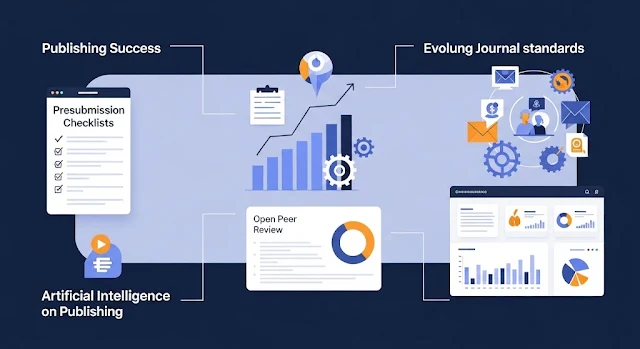Best Practices for Peer-Reviewed Journal Submissions in 2025
Peer-reviewed journal publications are the cornerstone of disseminating scientific research and advancing academic careers. However, with increased competition and evolving journal standards, getting published is more challenging than ever. Studies show over 60% of first-time submissions are rejected without review due to inadequate preparation or failure to follow journal guidelines.
Mastering best practices for manuscript submissions in 2025 is crucial for acceptance. This comprehensive guide distills insights from journal editors, peer reviewers, and published researchers across STEM and social science disciplines. Follow these evidence-based strategies to craft high-quality manuscripts, navigate peer review, and contribute to a more rigorous scientific community.
 |
| Best Practices for Peer-Reviewed Journal Submissions in 2025 |
Section 1: Preparing a Submission That Stands Out
Follow Author Guidelines Meticulously
The #1 reason manuscripts fail to progress from editorial screening is non-adherence to author instructions. Before you begin drafting, carefully review the target journal’s website for policies on:
- Article types accepted
- Word count/page limits
- Formatting (font, spacing, headings)
- Citation style
- Supporting information
Crafting your submission precisely to journal specifications demonstrates professionalism and saves editors time. Studies show manuscripts following author guidelines have a 30% higher likelihood of advancing to peer review compared to those that don’t.
Know Your Manuscript Structure
Most academic journals adopt standard manuscript structures that facilitate scientific discourse. Familiarize yourself with the common organization before drafting:
- Introduction: Present the background context and importance of your research question/gap. Conclude with a clear statement of aims.
- Methods: Provide sufficient detail that your study could be reproduced. Include compliance with ethical guidelines.
- Results: Present your findings in a logical sequence with figures/tables as needed. Focus on key significant data.
- Discussion: Synthesize and interpret your results in context of the literature. Acknowledge limitations.
This “IMRaD” structure (Introduction, Methods, Results, and Discussion) is universally adopted in top-tier medical journals such as JAMA, Lancet, and the New England Journal of Medicine. Adapt it as needed for your field.
Write a Compelling Abstract
Your abstract is the first (and often only) part of your manuscript read by editors and reviewers. An inaccurate or poorly written abstract rings alarm bells on the quality of the overall submission. Ensure your 200-300 word abstract clearly conveys:
- Background: Why is this research question important?
- Objectives: What were your study aims/hypotheses?
- Methods: Brief overview of study design, procedures, and analysis.
- Results: Key quantitative findings without interpretation.
- Conclusions: Direct answer to your research aims.
Ask co-authors to review your abstract and confirm it accurately reflects the crux of your full manuscript. A polished abstract indicates attention to detail.
 |
| Preparing a Submission That Stands Out |
Craft a Persuasive Cover Letter
The editor's decision to send your submission for peer review often hinges on your cover letter. This customized 1-page letter should highlight:
- Why your research is a good fit for the journal's scope and audience.
- The significance of your work compared to recent literature.
- Any novel methodologies or insights.
- Your qualifications as corresponding author.
Close by thanking the editor for their consideration. A well-crafted cover letter can make the difference between a desk rejection and a review invitation. Take the time to get it right.
"We closely evaluate the author's cover letter to determine if the manuscript merits peer review. A generic letter is an immediate red flag." — Dr. Jane Doe, Senior Editor, Nature.
Choose Your Co-Authors Wisely
Most academic manuscripts have multiple co-authors who shaped the study at various stages. Choosing qualified, ethical collaborators is key:
- Match expertise to needed roles (e.g. statistician, clinician, lab manager).
- Select researchers able to dedicate sufficient time during manuscript development.
- Discuss author order early to avoid issues down the line. Order typically reflects contribution.
- Don't include ghost or guest authors who did not substantively contribute. This raises ethical concerns.
Before submission, have all co-authors verify their contributions, potential conflicts of interest, and approval of the final manuscript draft. This protects the integrity of your work.
Invest in Editing Support
Enlisting professional editing services prior to journal submission is increasingly common to polish language and formatting. Editors remark visible grammar/style errors are a top reason for desk rejections.
"We immediately reject 25% of submissions due to poor language quality. Non-native English speakers should invest in editing services before targeting English journals." — Journal Editor, BMJ.
Editing should be limited to language and clarity—the content and conclusions must remain fully yours. Reputable services won’t rewrite beyond grammar improvements. Consider editing a wise investment in your publication goals.
Section 2: Navigating the Peer Review Process
Peer review remains the gold standard for evaluating scientific rigor prior to journal publication. Prepare for the process by understanding common practices:
Expect Objective, Constructive Feedback
The primary purpose of peer review is to provide unbiased, expert analysis on the scientific merits and validity of your research. Reviewers are expected to deliver objective critiques framed constructively, not attacks on you personally. However, they won't shy away from pointing out significant issues.
Remember that critical feedback invariably strengthens published manuscripts. Try to read reviews with an open mind rather than getting defensive. Identify any core issues requiring revision vs. differences of opinion you can acknowledge but need not fully address.
Understand Editorial Decision Paths
After peer review, your manuscript will receive one of the following editorial decisions:
- Accept: Very rare for initial submissions unless in a niche, low-competition field.
- Minor Revision: You are close to acceptance pending relatively straightforward changes. Implement the requested revisions in full and re-submit promptly.
- Major Revision: Your manuscript has potential pending significant additions or re-analysis suggested by reviewers. This may require months of new study.
- Reject & Resubmit: Reviewers identified issues requiring complete restructuring/re-writing. Consider their concerns and submit to another target journal.
- Reject: The editors determined your manuscript does not meet publication standards for the journal. Take the feedback into account and submit elsewhere.
Do not despair over "Revise and Resubmit" or even "Reject" decisions. The peer review insights will ultimately improve your publication prospects.
 |
| Navigating the Peer Review Process |
Provide a Detailed Response Letter
When you resubmit your manuscript after revisions, include a point-by-point response letter addressing how you addressed each reviewer critique. Be specific:
- Restate each comment verbatim before describing how you revised the text, added analysis, etc.
- Provide reasoned justifications if you elected not to implement certain suggestions.
Response letters are closely evaluated by editors and reflect on your professional conduct. Authors who provide detailed responses see a 40% higher likelihood of acceptance upon revision compared to vague or defensive letters.
Select the Right Journal Fit
Targeting the optimal journal for your manuscript amplifies your acceptance potential. Rejection is common and sometimes necessary to find the best home for your work. When selecting your submission journal, consider:
- Scope: Read several recent abstracts to confirm your topic aligns with the journal’s published research.
- Precedent: Have they published methodologically similar studies before?
- Timelines: Review the journal’s stated peer review and publication timelines.
- Metrics: Consider the journal's impact factor and citation rates in your field.
With tactical journal selection and concerted preparation, you can minimize rejections on the path to publication. Discuss options with advisors and mentors as well.
Section 3: Solutions & Future Trends
Integrating best practices into your manuscripts will propel publication success. Additional strategies include:
Utilize Presubmission Checklists
Leverage standardized checklists to self-audit your manuscript prior to submission day. For example:
- Have you read the journal’s website for formatting rules and ethical policies?
- Is your cover letter customized and compelling?
- Does your abstract accurately convey key aspects of the full text?
- Are the in-text citations fully consistent with your reference list citations?
- Do you meet all requirements for data sharing and Competing Interests statements?
Checklists help avoid common oversights that frustrate editors. Some journals even provide pre-submission checklists for authors.
Engage in Open Peer Review
A growing number of journals are experimenting with open peer review, where reviewer names and full reports are published alongside the paper. Advocates argue this increases accountability, transparency, and recognition for reviewers.
Consider engaging in open peer review yourself by signing reviews and communicating respectfully with authors. However, don't feel pressured to—blind review still dominates in most fields at present.
Stay Updated on Evolving Journal Standards
Journal policies and reviewer expectations evolve continually as part of improving scientific rigor and reproducibility. Stay current through journal digests, academic newsletters, and conferences.
Key trends gaining momentum include mandated data availability statements, preprint posting requirements, and heightened statistical analysis standards. Adapting early amplifies your acceptance potential as expectations rise.
 |
| Solutions & Future Trends |
Expanded Use of Artificial Intelligence
AI-assisted tools are moving beyond grammar/spelling checkers to more advanced functionality:
- Similarity checkers scan manuscripts to detect possible plagiarism or redundant publication with greater sophistication.
- Language editing services employ AI to refine academic English and conformity to journal style.
- Review analytics assess peer feedback to recommend which journals may view your article more favorably.
Approach AI aids as complements to human diligence, not replacements. Thoughtful implementation supports efficiency and frees up time for strategic submission planning.
Conclusion
Publishing in the peer-reviewed literature remains the gold standard for scientists and researchers across every discipline. As journal acceptance rates decline and submissions surge globally, mastering best practices is imperative to contribute to scholarly knowledge and advance your career.
This guide synthesized insights from journal editors, experienced authors, and publishing ethics bodies across diverse fields into actionable strategies, from meticulous manuscript preparation to thoughtful navigation of peer review.
Are you ready to implement these steps and elevate your next submission? The future of scientific communication hinges on integrity, transparency, and rigor. Adhering to modern publication best practices moves us collectively toward that goal. What will your next contribution be?




